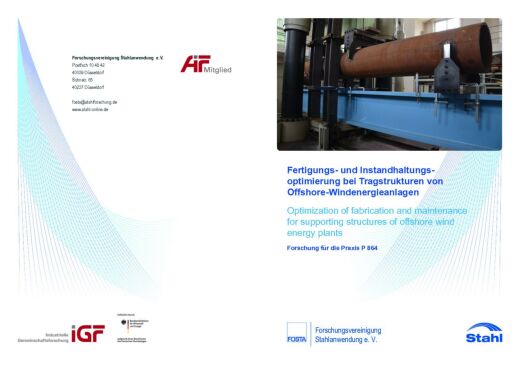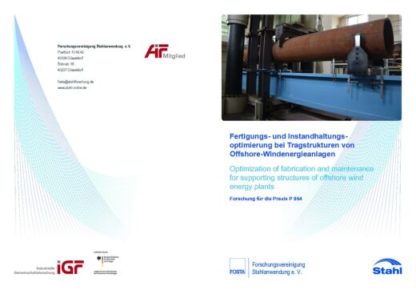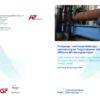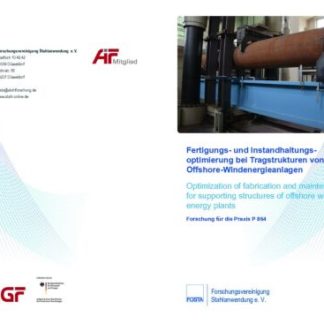Description
P 864 – Optimization of fabrication and maintenance for supporting structures of offshore wind energy plants
Supporting structures for offshore wind energy plants such as Jackets or Tripods are often realized as welded structures made of circular hollow sections. During service life, these structures are exposed to wind and wave loads as well as loads from the plant operation itself. As a result of the dynamic loading conditions, fatigue design is the major design consideration. Therefore, the development of optimized manufacturing processes as well as the development of effective maintenance procedures are of major importance.
Within the research project the fatigue strength of welded joints frequently used in offshore structures was investigated. The research work concentrated on the fatigue performance of girth welds as well as girth welds with partial penetration. Based on the documented manufacturing steps of the experimentally investigated girth welded joints, the individual manufacturing processes were evaluated economically and ecologically. For maintenance of existing steel constructions, a repair procedure was developed and its effectiveness was investigated.
For girth welded circular hollow sections, which are welded from one side only, a comparison of FAT-classification according to different standards and recommendations showed that this constructional detail is not evaluated in a consistent way. In order to establish an appropriate FAT-classification, a fatigue testing program was developed and extensive experimental and numerical investigations were carried out. Based on the results, the fatigue strength of girth welded pipes was determined and a recommendation for FAT-classification is given. Additional studies contribute to identify and evaluate effects which are relevant to fatigue such as the influence of imperfections. The developed recommendation can serve as a basis for future consideration in standards and guidelines.
Possible areas of application were reviewed for partial penetration girth welds and their fatigue behaviour was analysed. Numerical simulations and theoretical considerations proved the unfavourable fatigue behaviour of these kind of joints under tensile loads. The theoretical studies were confirmed by the conducted fatigue tests. The results contribute to expand the knowledge within the research focus on full penetration girth welds and provide information on the fatigue behaviour of joints with weld defects.
A comprehensive documentation of the single process steps during manufacturing of specimens allowed to perform concluding analyses dealing with the economic and ecologic impacts within the production stage. Furthermore, the contribution of the different process steps to the overall result was pointed out. It was shown for the life cycle assessment studies that circular hollow sections with small diameter tend to cause bigger potential environmental effects when a reference to the size of the circular hollow section and the number of weld layers is made. A significant reduction in the impact of the process step of producing the filler and capping passes was determined by using an orbital welding device, wherein the advantages of orbitalwelding increases with increasing hollow section diameters. This can also be applied to the results of the economical comparison.
With regard to maintenance of supporting structures for offshore wind energy plants, a maintenance procedure was developed and applied to welded joints with an offshorerelevant thickness. In particular, the effectiveness of a high frequency hammer peening (HFMI) treatment subsequent to weld repair was investigated and the applicability of available design recommendations was evaluated. The fatigue tests showed that components which are subjected to a HFMH-treatment after weld repair can be shifted into the new condition again in terms of the resulting lifetime. Furthermore, the fatigue strength was even increased. The applicability of existing design recommendations has been confirmed on the basis of the results. The developed method can be used for welded structures in a variety of applications, such as steel, machinery and plant construction.
The research project (IGF-Nr. 16586 N) was carried out at Karlsruher Institut für Technologie (KIT), Versuchsanstalt für Stahl, Holz und Steine, Karlsruhe und von der Bundesanstalt für Materialforschung und -prüfung (BAM), Berlin. FOSTA has accompanied the research project work and has organized the project funding from the Federal Ministry of Economics and Technology through the AiF as part of the programme for promoting industrial cooperation research (IGF) in accordance with a resolution of the German parliament.
Only available in german language.
Authors:
T. Ummenhofer, P. Weidner, T. Zinke, M. Mehdianpour, A. Rogge
Published in:
2016




